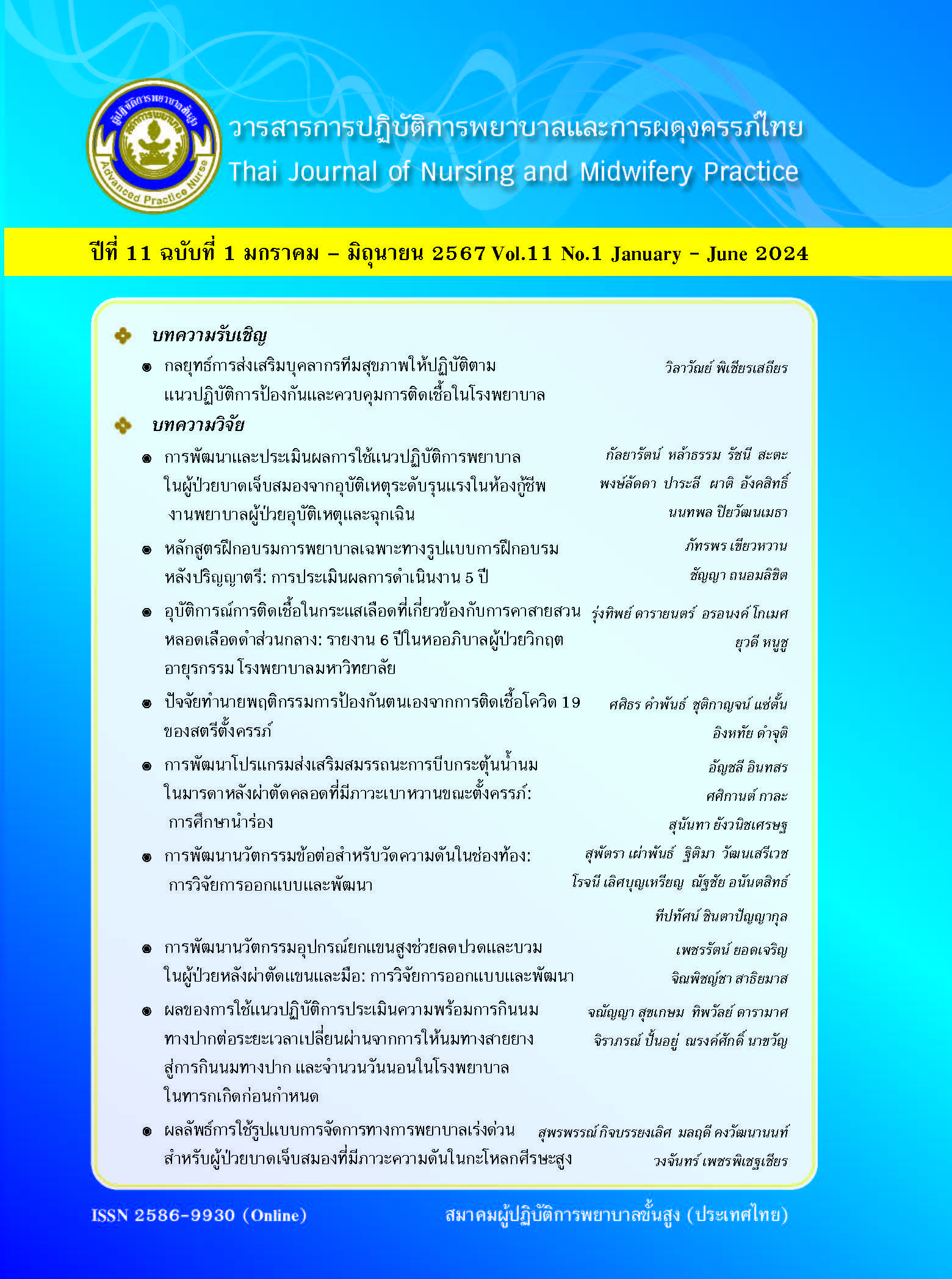หลักสูตร์ฝึกอบรมการพยาบาลเฉพาะทางรูปแบบการฝึกอบรมหลังปริญญาตรี: การประเมินผลการดำเนินงาน 5 ปี
Main Article Content
บทคัดย่อ
การวิจัยนี้ เป็นการศึกษาแบบย้อนหลังและภาคตัดขวาง มีวัตถุประสงค์เพื่อประเมินผลหลักสูตรฝึกอบรมการพยาบาลเฉพาะทางรูปแบบการฝึกอบรมหลังปริญญาตรี โดยใช้แนวคิดการประเมินปัจจัยด้านบริบท ปัจจัยนำเข้า กระบวนการและผลผลิตของสตัฟเฟิลบีม ร่วมกับโมเดลเคิร์กแพททริก เก็บรวบรวมข้อมูลย้อนหลังจากฐานข้อมูลการฝึกอบรมซึ่งเป็นข้อมูลของผู้ผ่านการอบรมระหว่างปี พ.ศ. 2561-2566 จำนวน 422 คน
และเก็บข้อมูลแบบตัดขวาง โดยใช้แบบสอบถามจากผู้บริหารทางการพยาบาล อาจารย์คลินิกประจำหอผู้ป่วยและพยาบาลพี่เลี้ยง จำนวน 291 คน วิเคราะห์ข้อมูลโดยใช้สถิติเชิงบรรยาย การวิเคราะห์ความแปรปรวน และสถิติที่คู่ ผลการวิเคราะห์ปัจจัยด้านบริบท ปัจจัยนำเข้า และกระบวนการ พบว่ามีความเหมาะสมในระดับมากถึงมากที่สุด ด้านผลผลิตของหลักสูตร พบว่าผู้เข้าอบรมมีความพึงพอใจต่อหลักสูตรระดับปานกลางถึงมากที่สุด ผู้เข้ารับการอบรมทุกคนผ่นการประเมินสมรรถนะ (ร้อยละ 100) การปฏิบัติงานด้วยสมรรถนะทางการพยาบาลเฉพระทางดีขึ้นกว่าก่อนการอบรม และสมรรถนะยังคงอยู่ต่อเนื่องภายหลังการอบรม 6 เดือน อย่างมีนัยสำคัญทางสถิติ (P <.05) ค่าเฉลี่ยคะแนนความมั่นใจเพิ่มขึ้นและความเครียดในการปฏิบัติงานลดลงอย่างมีนัยสำคัญทางสถิติ (p <.05) ผลการวิจัยนี้สามารถนำไปใช้เป็นข้อมูลเบื้องต้นสำหรับฝ่ายการพยาบาลในการจัดอบรมร่วมกับสถาบันการศึกษาที่มีความประสงค์ในการวางแผนพัฒนาหลักสูตรที่เหมาะสมโดยคำนึงถึงปัจจัย
ด้านบริบท ปัจจัยนำเข้า กระบวนการ และผลผลิต
Downloads
Article Details

อนุญาตภายใต้เงื่อนไข Creative Commons Attribution-NonCommercial-NoDerivatives 4.0 International License.
เอกสารอ้างอิง
International Council of Nurses. International Council of Nurses guidelines on Advanced Practice Nursing 2020. Geneva: International Council of Nurses; 2020.
Thailand Nursing and Midwifery Council. Post Baccalaureate Residency Training [Internet].2019 [cited 2023 Oct 30]. Available from: https://www.tnmc.or.th/images/userfiles/files/Residency Training2562.pdf. Thai.
Bratt M. Nurse Residency Program: Best practice for optimizing organizational success. J Nurses Prof Dev. 2013; 29(3): 10210-. doi: 10.1097/NND.0b013e318292649f.
Duchscher JB. A process of becoming: The stages of new nursing graduate professional role transition. J Contin Educ Nurs. 2008; 39(10): 441-50. doi: 10.3928/00220124-20081001-03.
Stufflebeam DL. The CIPP Model for program evaluation. In: Madaus FF, Scriven M, Stufflebeam DL, editors. Evaluation models: Viewpoints on educational and human services evaluation. Norwell: Kluwer; 1983. p.117-41.
Frye AW, Hemmer PA. Program evaluation models and related theories: AMEE Guide No. 67. Med Teach. 2012; 34(5): e288-99. doi: 10.3109/0142159X.2012.668637.
Alsalamah A, Callinan C. Adaptation of Kirkpatrick’s four-level model of training criteria to evaluate training programmes for head teachers. Educ Sci. 2021; 11(3): 116. doi: 10.3390/educsci11030116.
Gandomkar R. Comparing Kirkpatrick’s original and new model with CIPP evaluation model. J Adv Med Educ Prof. 2018; 6(2): 94-5.
Kirkpatrick J, Kirkpatrick W. An introduction to the new world Kirkpatrick model. Georgia: Krikpatrick Partners, LLC; 2019.
Lee SY, Shin JS, Lee SH. How to execute Context, Input, Process, and Product evaluation model in medical health education. J Educ Eval Health Prof. 2019; 16: 1-8. doi: 10.3352/jeehp.2019.16.40.
Mellor P, Gregoric C, Atkinson LM, et al. A critical review of transition-to-professional-practice programs: Applying a standard model of evaluation. J Nurs Regul. 2017; 8(2): 23-30. doi: 10.1016/S2155-8256(17)30095-9.
Yamane T. Statistics: An introductory analysis. 3rd ed. New York: Harper & Row Ltd.; 1973.
The Healthcare Accreditation Institute (Public Organization). Hospital and healthcare standard. 5th ed. Bangkok: Kor Karn Pim Thien Kwang Co.Ltd; 2022. Thai.
Carlisle B. Supporting Nurse Residency Programs by determining nurse residency value [MSN Capstone Projects. Paper 187]. Texas: University of Texas at Tyler; 2022.
Williams FS, Scott ES, Tyndall DE, et al. New nurse graduate residency mentoring: A retrospective crosssectional research study. Nursing Economics. 2018; 36(3): 121-7.
Szarejko K, Burns H. The nurse residency education navigator: Educator, facilitator, and clinician. J Contin Educ Nurs. 2021; 52(2): 79-84. doi: 10.3928/00220124-20210114-07.
Thanomlikhit C, Khewwan P. Nurse residency coordinator: The role in nursing competency development. TJNMP. 2018; 5(2): 96-110. Thai.
Brunt BA, Morris MM. Nursing professional development [Internet]. [Updated 2022 Sep 20]. In: StatPearls Treasure Island (FL): StatPearls Publishing; 2023 Jan-. Available from: https://www.ncbi.nlm.nih.gov/books/NBK531482/


